#Biedermeier era fashion
Photo

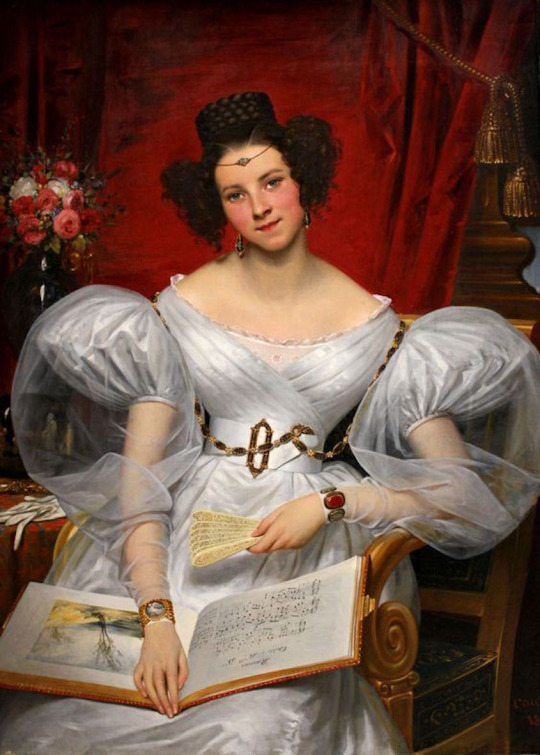




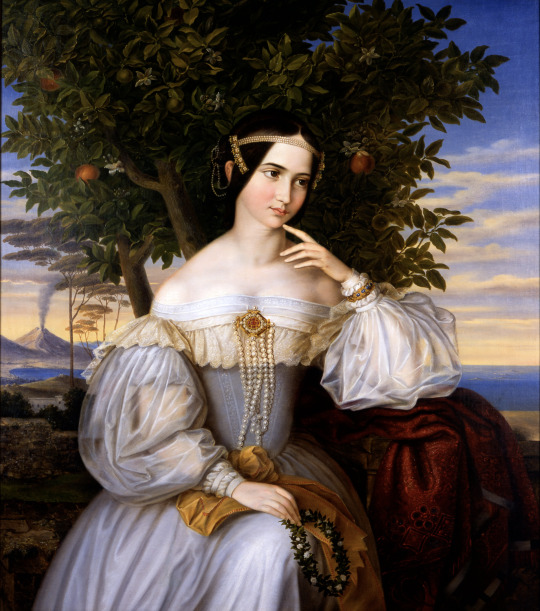
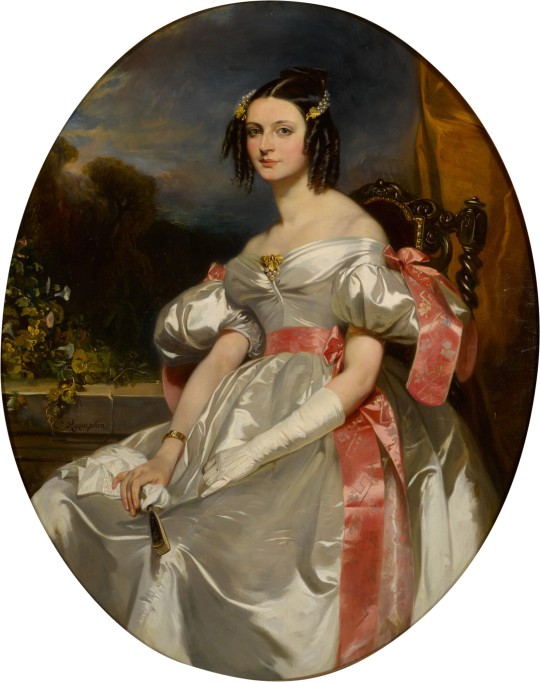
More pre-Victorian 1830s (from top to bottom) -
ca. 1830 Evening or wedding dress (location ?). From tumblr.com/andrayblue 1080X1350.
1831 Marquise Chasseloup-Laubat (probably Marie Augustine Antoinette Le Boucher des Fontaines) by Joseph-Désiré Court (Musée des Beaux-Arts de Rouen - Rouen, Normandie, France). From their Web site' enlarged by half 845X1181.
1830-1832 María Cristina de Borbón, Queen of Spain by José de Madrazo y Aguado (Prado). From their Web site 1280X1745.
1832 Marie Franziska von Freytag by ? (Salzburg Museum - Salzburg, Salzburgland, Austria). From tumblr.com/history-of-fashion 766X963.
1832 Amalie Klein by Friedrich von Amerling (Österreichische Galerie Belvedere - Wien, Austria). From tumblr.com/history-of-fashion; fixed spots & cracks throughout w Pshop 2893X3508.
1835 Illustration from La Mode by Paul Gavarni. From tumblr.com/clove-pinks 1650X2048.
1836 Marriage Portrait of Charlotte de Rothschild by Moritz Daniel Oppenheim (Israel Museum - Jerusalem, Jerusalem District, Israel). From Google Art Project.
Lady with Pink Sash by Camille Joseph Etienne Roqueplan (Sotheby's - 29Jan22 auction Lot 703) 1583X2000.
#1830s fashion#Romantic era fashion#Biedermeier fashion#Louis-Philippe fashion#natural waistline#Marquise Chasseloup-Laubat#Joseph-Désiré Court#cross over bodice#chemise#quarter-length puffed inner sleeves#long sheer outer sleeves#ferroniere#María Cristina de Borbón#court dress#Marie Franziska von Freytag#Apollo knot#Amalie Klein#Friedrich von Amerling#Gigot sleeves#Paul Gavarni#Charlotte de Rothschild#Moritz Daniel Oppenheim#Camille Joseph Etienne Roqueplan#waist band#full skirt
153 notes
·
View notes
Text
15 Trending Wedding Bouquet Ideas 2021
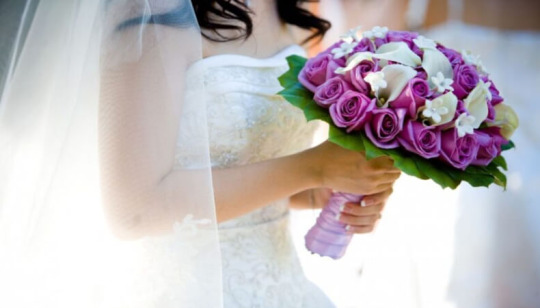
One of the most enjoyable aspects of wedding planning is selecting the right wedding bouquet. There are so many beautiful styles that choosing your favorites can be difficult. To get you started, we have rolled out the 15 most popular wedding bouquet ideas.
Here we go….
1. Posy Bouquet

A posy bouquet is one of the popular choices for brides. As the name says, it is a small, round flower arrangement grouped in an unstructured way and tied, usually with a ribbon. Many brides prefer to carry just three or four of the same long-stemmed flowers, such as White lily-of-the-valley blossoms, which are available in May, are the most classic of all blossoms.
Tie a small posy with a wide sage green satin ribbon to make a divine little bouquet to wear with a lace gown. White peonies, sweet peas, hyacinths, ranunculus, and tulips are among the other springtime favorites. White Casablanca lilies are also an excellent choice for a dramatic bouquet.
2. Hand-tied Bouquet

As the name suggests, Hand-tied Bouquets are a bunch of flowers tied together using a ribbon, string, wire, or a piece of fabric. More often than not, these bouquets are unstructured floral arrangements, giving them a perfectly rustic and bohemian look.
These minimalist bouquets are known for their casual appearance, which stems from the loose and slightly haphazard floral arrangement. You can easily DIY this bouquet, as it’s very easy to make. All you need to do is gather a variety of flowers and tie them together – and you have your stylish wedding bouquet ready for the day!
3. Button Bouquet
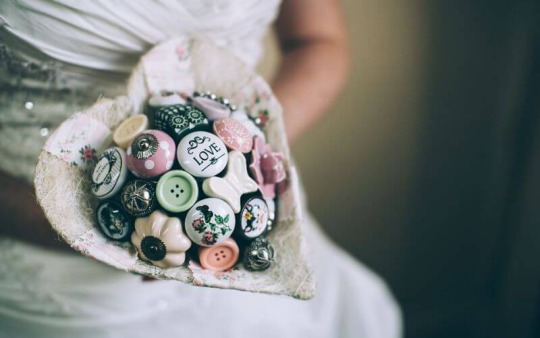
The button bouquet consists of 40 button stems, many of which are topped with stunning clear vintage glass buttons. You can create a button bouquet of your choice that complements your wedding theme. For instance, you can have all whites have a white-inspired button bouquet for your wedding. Or, if you want, you can use colorful button stems for a dramatic bouquet. This style looks classy and vibrant. These are the perfect choice for DIY enthusiasts because all you need is different kinds of button stems to create such a stunning bouquet. You can also buy button bouquets online.
4. Nosegay Bouquet
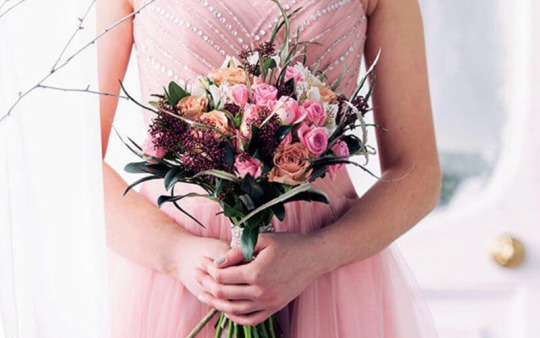
One of the most popular styles of wedding bouquets is the nosegay bouquet. A nosegay is a more structured bouquet made up of a small, tightly packed group of flowers that are all cut to the same length. The stems are tightly wrapped in ribbon or lace, and a stiff backing often supports the bouquet to give it shape. The term nosegay originated in fifteenth-century Middle English as a combination of the words nose and gay (the latter then meaning “ornament”). As a result, a nosegay is an ornament that appeals to the nose or nostrils.
RELATED: 11 Best Wedding Cake Alternative Ideas For The Couple
Traditionally, a nosegay bouquet contains only one type or color of the flower, though modern bouquets may deviate from this rule. A nosegay bouquet is distinguished by the presence of a large focal flower that draws attention to the floral arrangement. They look best when formed from a variety of flowers, such as daisies, roses, irises, and carnations with complementary tones. Nosegay bouquets are similar to posy bouquets in appearance, but nosegays emphasize greens. Greens are added around the contour of the flower cluster creating a beautiful border.
5. Biedermeier bouquet

The Biedermeier bouquet is ideal for the bride who strives for perfection on her wedding day. It is named after a German-style of interior design and is structured similarly to a nosegay. It was created in Germany in the first half of the nineteenth century, during a period of relative prosperity and the rise of the middle class. A Biedermeier floral design is typically round or conical in shape, with concentric patterns in circles or spirals.
It is made up of various types of flowers that are arranged in such a way that they form rings of multiple colors. You can customize the Biedermeier bouquet to any size based on your preferences and tastes. You can get a simple two-layered bouquet made or as many as eight or ten floral rings forming a magnificent Biedermeier bouquet for the wedding ceremony. The Biedermeier bouquet looks best when created with orchids, roses, dahlias, and tulips bordered by vibrant green foliage or textured leaves and ferns.
6. Pomander bouquet

Pomander bouquets, also known as kissing balls, are a bit offbeat choice for a bridal bouquet. However, they appear romantic and youthful on a bride. Often Pomander bouquets are used for bridesmaids or flower girls.
They have a ribbon handle or a string so that the bride can carry it like a handbag. Gems and jewels are frequently used as an embellishment on or around the blooms in pomander bouquets. Pomanders are commonly made with gerbera daisies, carnations, roses, anemones, and sunflowers.
7. Cascade Bouquet
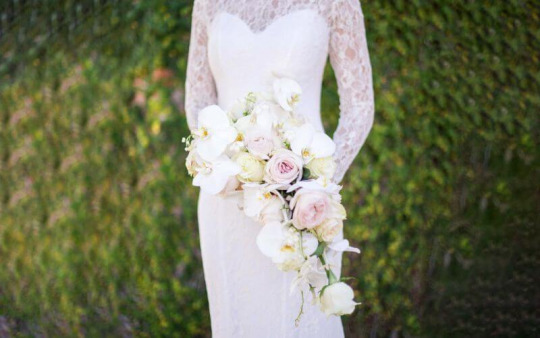
The cascade bouquet, also known as waterfall bouquet, is a very traditional and elegant form of a bouquet. The flowers are arranged to appear to flow over the bride’s hands and tapers near the bottom. At the wedding of Lady Diana Spencer and the Prince of Wales at Westminster Abbey in the 1980s, it became popular as the arrangement of choice. This bouquet can be very large, but the smaller modern versions are often referred to as teardrop or trail bouquets. They have a beautiful mix of flowers, long trailing vines, and draping leaves, making a stunning floral arrangement that appears like a “waterfall” of flowers. They make a perfect choice for high-end destination wedding ceremonies or themed wedding parties.
It is a perfect choice for brides looking for ways to make a strong style statement at their wedding. Their inverted teardrop shape looks spectacular against wedding gowns. Waterfall bouquets are typically hand-tied with floral foams, wires, and ribbons. They look best when created with bold and vibrant blooms such as hyacinths, lilies, dahlias, and garden roses and accented with Baby’s Breath and various types of greenery, such as ivy.
8. Composite bouquet

The composite flower bouquet is a game-changer! It is composed of hundreds of single petals rather than flower heads. The petals can be collected from any flower, but those with large and thick petals are preferred. These petals are then wired together on a single stem, giving the bouquet the appearance of a single, large circular bloom. This is a pricey option but can add both magnificence and elegance to your wedding celebration.
9. Basket Bouquet
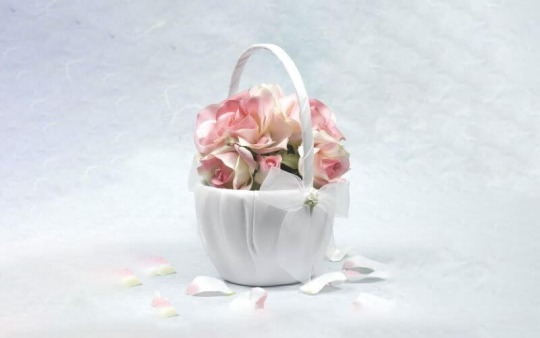
The basket bouquets are great for outdoor or garden weddings. They are treasured for their rustic appeal because the flowers are arranged in an oasis inside the basket, where they won’t wilt as quickly as other bouquet styles. Basket bouquets are quite popular among flower girls and young bridesmaids because they are easier to carry than nosegays or posy bouquets.
A tussy mussy bouquet is a nosegay-style bouquet carried in a small vase made of metal, porcelain, or any other material that complements your wedding theme. Some tussy mussy bouquets come with a small chain to help you carry them. This bouquet is easy to display at your reception, and the vases make excellent thank you gifts for your bridesmaids.
10. Brooch Bouquet

Brooch bouquets are a unique and modern way to add a touch of whimsy to your wedding. As the name implies, they just add glam to your wedding. The best part is you can incorporate everything from sequins and sparkles to sensational new color shades to your brooch bouquet.
Although Brooch bouquets are the latest trend, brides who adore the idea of vintage style can make them feel a little retro while being modish! One of the keys is to be creative with your color palette, using shades that go perfectly well with your wedding theme while evoking the look and feel of an antiquated era.
11. Presentation bouquet

A Presentation bouquet, also known as pageant bouquets, is a popular choice of arrangement. They are commonly used in pageant competitions. It’s a perfect choice for a glamorous bride to add a bit of drama to her wedding bouquet style.
These bouquets are rather large floral arrangements with crisp and decorous blooms evoking a lush and luxurious look. The overall size of the bouquet varies; however, the extravagance remains constant. For presentation, bouquets, orchids, delphiniums, calla lilies, roses, sweet peas, and various tropical flowers are commonly used to create pageant bouquets.
12. Tussy Mussy Bouquet

Tussie mussies, also known as tussle mussle bouquets, were introduced to England in the early 18th century and quickly became a fashionable accessory for young women. A tussie mussie is a small circular bouquet, similar to a nosegay, but it contains symbolic meaning based on the ‘language of the flower.’ Specific flowers represent specific sentiments. Tussie mussies are traditionally arranged in a cone- or cornucopia-shaped container made of silver or tin, with a chain attached to carry the bouquet.
13. Fan bouquet

A fan bouquet, which consists of a simple plastic fan intertwined with flowers and leaves, is ideal for a vintage wedding, tropical wedding, or Asian-themed wedding. They are of two types; flower arrangements are arranged in an outward spreading pattern. The leaves and blooms are placed in a container resembling two Japanese fans placed side by side, creating a distinctive shape that stands out from traditional bridal bouquets.
14. Round Bouquets

As the name suggests, round bouquets are round-shaped bouquets used on numerous occasions, including weddings. Any floral arrangement that is round in shape is referred to as a round bouquet, including Posy bouquets.
Round bouquets come in various sizes, flower shapes, and color combinations. Myriads of ferns, leaves and other greens are used in round bouquets; however, flowers are the main attraction. Any bulbous-shaped blooms, including dahlias, chrysanthemums, garden roses, ranunculus, and anemones, are used to make round bouquets.
15. Dried Flower Bouquet
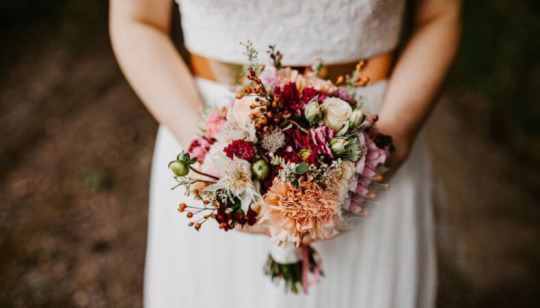
Lastly, we have dried flower bouquets. These bouquets are the hottest trend in the wedding industry. As the name implies, a dried flower bouquet is made of non-fresh dried flowers. Dried flowers are a novel way to preserve the beauty of a significant flower bouquet that may have sentimental value or simply if you believe it is a waste to throw away the fresh flower bouquet.
These bouquets are the perfect choice for vintage and modern wedding ceremonies. These are for experimental and trend-forward brides as they love incorporating unique textures to their wedding. The unusual blooms, dried grasses, seed pods, and other long-lasting botanicals make for a pretty impressive wedding bouquet that stands out.
Wrapping it up…..
These are the 15 best wedding bouquet ideas to get inspired by. All these wedding bouquets look classy, magnificent, and attractive. All you have to do is just be a little creative while giving instructions to your wedding florist. The best thing is all these wedding bouquets can be customized according to your wedding theme.
Happy Wedding…
2 notes
·
View notes
Text
History of porcelain dolls

Porcelain doll (or so-called bisque doll) is a doll that is wholly or partially made out of bisque porcelain, a type of porcelain that is unglazed and matte. Bisque dolls were the most popular from 1860 to 1900 in France and Germany and became fashionable after china dolls who have glazed texture.

Left: 15″ French Fashion Lady, sold for $3,000 via Apple Tree Auction Center (May 2018). Right: 18″ Shouldhead Attributed to Kling, c. 1870, sold for $325 via Milestone Auctions (May 2018).
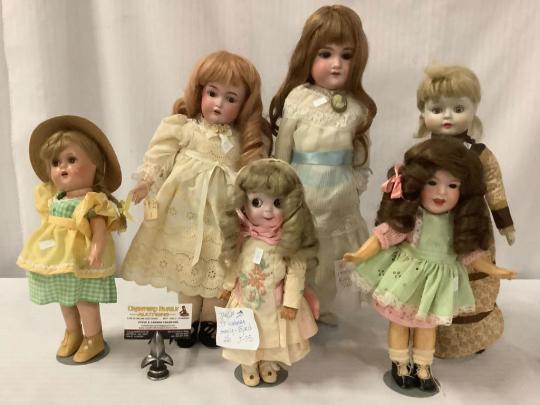
Bisque dolls have matte texture and are more skin-like. They were initially made as children’s toys but in time became collectible and today they can be worth thousands of US dollars.
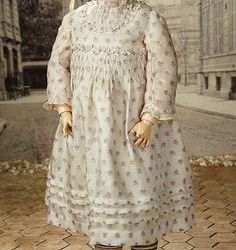
Bisque dolls are rarely made completely out of bisque because that makes them heavy and fragile. The most often they are made from the combination of materials. The head of the doll is always made from bisque but body is made of cloth, leather, wood (with joints), papier-mâché or composition, which is a material made of pulp, sawdust, glue, cornstarch, resin and wood flour. Eyes of dolls are made of glass. Head is painted in many layers in order to get skin tones and facial expressions.
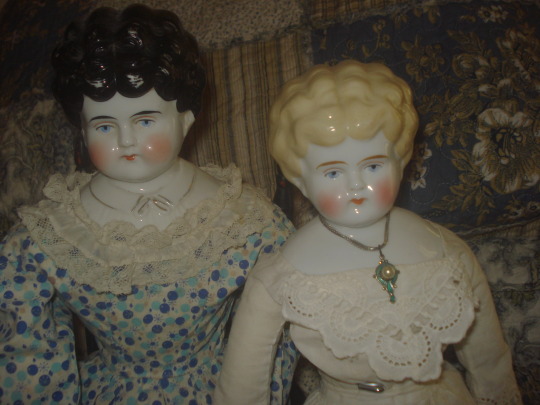
First porcelain doll manufactured in Europe were china dolls. China dolls ranged in size with specific physical attributes that reflected the time in which they were created. Some of the earliest dolls depicted adult women. These older models tended to have high foreheads and middle-parted hair that was smoothed down into rows of curls tucked behind ears. The painted, molded hair. While heads were always made of porcelain, some of the older models were even placed on peg-jointed wooden bodies.

1830-1850 Biedermeier China Doll, sold for $110 via Milestone Auctions (May 2018).
They were made mainly in Germany between 1840 and 1880 from glazed porcelain and with painted hair. From 1850, Germany manufactured parian dolls - white porcelain dolls that were not glazed before firing which gave them matte texture.
German china dolls had black molded hair and painted blue eyes, though brown or stationary glass eye models can be found occasionally in the market. China dolls created from 1850 to 1870 featured extravagant hairstyles that resembled the Parisian style of the era. During this time, doll makers became more innovative, adding ribbons, curls, flowers, and braids to hairstyles
They also had painted hair. Manufacturing of bisque doll began in 1860s in France and Germany and continued well after World War I.
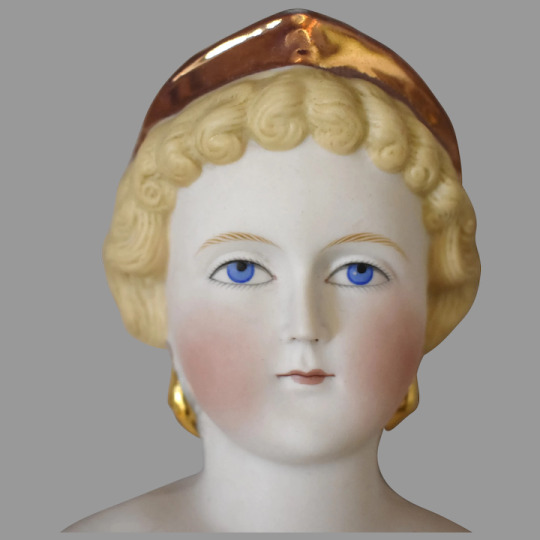
rubylane

Most famous French companies that manufactured bisque dolls were Jumeau, Bru, Gaultier, Rohmer, Simone and Huret


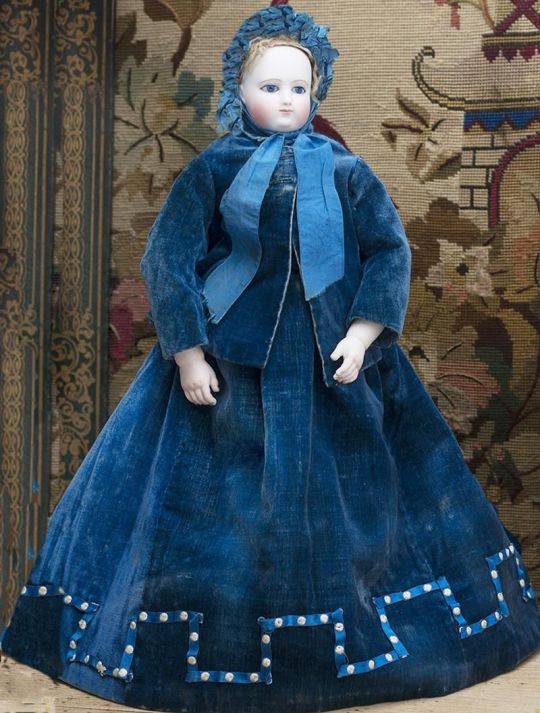
while heads for dolls were mostly made in Germany. They soon became very popular because of their matte texture that was closer to human skin than glazed porcelain and because they had more natural hair. Bisque dolls had wigs made from human hair or “mohair” - the hair of the Angora goat. First bisque dolls were fashion dolls. They represented grown up women in modern (for the time) clothes and were intended for children of wealthy parents. There were parts of the industry that functioned on making only clothes for dolls. Near the end of the 19th century childlike dolls started taking over the market and becoming very popular.


The most popular were French Bébés dolls high quality dolls made very skillfully. When German makers started making less expensive dolls they took over the market so French makers were forced to unite into consortium.

Germany dolly-faced dolls were made by companies Armand Marseille, Simon and Halbig, K*R, and Kestner many of which were placed in the Thuringia region, which has natural deposits of the clay used to make the dolls.

German Kestner No. 146, sold for $250 via Milestone Auctions (May 2018).
IN the early years of the 20th century companies like Kämmer and Reinhardt, Heubach and Kestner started making “character-faced dolls” which were more realistic and expressive childlike dolls.

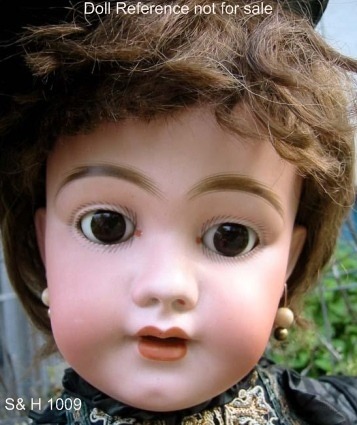
dollrefernce
At about the same time production of bisque dolls began in the United States and Japan too. During 20th century, making of dolls turns from industrial production to hobby and again to industrial production in 1980s. Now, older bisque dolls can be valuable collectable items.
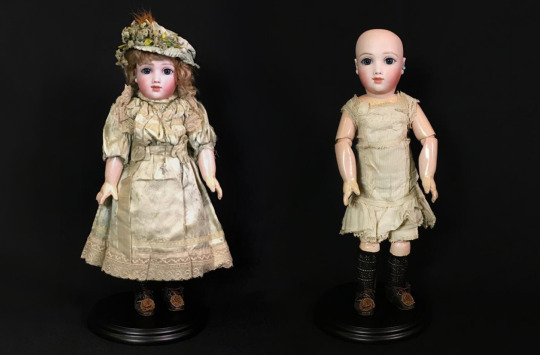
15″ A. Thuillier A.T. Bebe, $8,000 via Apple Tree Auction Center. (May 2018)

andrey´sdolls
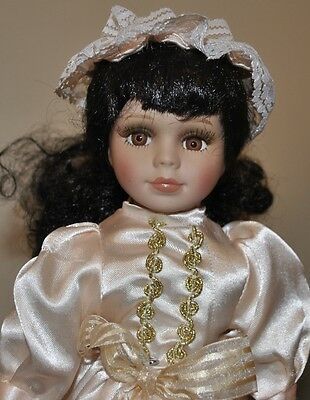


The price and value of your bisque doll is dependent on various factors. The way your doll’s face is painted, the style, and the appearance should all be taken into consideration. Bisque dolls are slightly translucent, but not chalky. It’s also important to assess the quality of the paint. Well-painted dolls have finely detailed painted eyelashes and eyebrows, well-accented lips, and the right dash of cheek blush. Make sure there aren’t too many black flecks or pin holes.

11″ Bru “Size A” Fashion Lady, sold for $1,600 via Apple Tree Auction Center (May 2018).
A rare German Kämmer & Reinhardt life-like doll became the world’s most expensive doll ever sold as it made $400,000 at Bonhams, Knightsbridge auction.

http://www.historyofdolls.com/doll-history & https://www.invaluable.com/blog/antique-porcelain-dolls/
Wow, this is amazing. Thank you😊❤️❤️❤️❤️
15 notes
·
View notes
Photo

This 1832 dress and bonnet displays the height of romantic-era fashion excesses with its massive gigot sleeves and huge-brimmed bonnet. Note the many small details, like the brooches pinned to the sleeve cuffs and the embroidered stockings.⠀ -⠀ -⠀ -⠀ #fashiondrawing #historicalclothing #periodclothing #historicalfashion #art #digitalart #dresshistory #costumedesign #clothingdesign #vintage #vintagefashion #style #fashion #historicalfashiondrawing #historicalfashiondesign #19thcentury #19thcenturyfashion #nineteenthcenturyfashion #nineteenthcentury #1830s #romanticera #romanticerafashion #biedermeier #1832 #gigotsleeves https://www.instagram.com/p/B-XBsqSgQB8/?igshid=6hfwb4cn6134
#fashiondrawing#historicalclothing#periodclothing#historicalfashion#art#digitalart#dresshistory#costumedesign#clothingdesign#vintage#vintagefashion#style#fashion#historicalfashiondrawing#historicalfashiondesign#19thcentury#19thcenturyfashion#nineteenthcenturyfashion#nineteenthcentury#1830s#romanticera#romanticerafashion#biedermeier#1832#gigotsleeves
0 notes
Text
The Versace Mansion is back in the spotlight, thanks to ‘American Crime Story’

Even producer Ryan Murphy can’t believe he was able to shoot at Villa Casa Casuarina
The South Beach mansion featured in producer Ryan Murphy's new American Crime Story season devoted to the murder of fashion designer Gianni Versace is no movie set. It's the real thing.
Twenty years after Versace's death, Murphy and crew headed to Miami to film parts of the show at the iconic 1930-era home that the designer carefully revived — what is now the boutique hotel The Villa Casa Casuarina. Chauncey Copeland, the hotel’s general manager, told the Associated Press that crew from the FX series spent about a month filming at the hotel. “It’s really striking just how accurate they are,” he said.
The hotel is still a memorial of sorts to Versace, where guests can live like the designer (if only for a weekend).
“We actually have preserved what Versace created here and just augmented it with some modern touches for the convenience of our hotel guests and restaurant patrons,” Copeland told the AP. The mansion’s famous Versace logo-emblazoned mosaic swimming pool is still there, although the hidden passageways the designer once used to traverse the huge mansion are now closed.
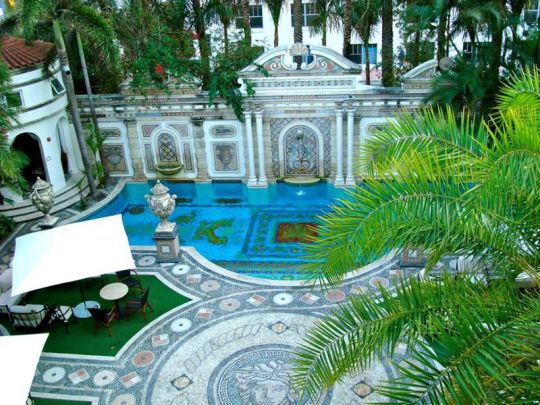
The Villa Casa Casuarina/Facebook
Villa Casa Casuarina’s so Versace pool (check out the Medusa logo)
The house itself will be almost be its own character in the The FX’s series The Assassination of Gianni Versace, which will premiere on January 17 with Edgar Ramirez as Versace.
Murphy told Page Six last month he couldn’t believe it when he received the permit to shoot there. “I don’t think I could have made the show if I couldn’t have gotten that house,” he said. “There was no way you could build [a set] of it. Two of the rooms were made out of seashells. [Gianni Versace’s sister] Donatella [Versace] took all the furniture and the art when she sold the house, but through pictures we were able to recreate them.”
“It adds something to the performance,” Murphy told Page Six. “When Edgar Ramirez goes to those Biedermeier closets [in Versace’s bedroom], they were the same closets Versace spent a year building and they’ve been lovingly maintained. They were extraordinary.”
Versace’s former mansion now a luxury hotel in Miami Beach [7 New Miami]
10 of Miami’s most iconic buildings, mapped [Curbed Miami]
Recreating Versace murder emotionally drained Ryan Murphy, cast and crew [Page Six]
from The Real Deal Miami & Real Estate News News | & Curbed Miami - All https://miami.curbed.com/2018/1/3/16846594/versace-mansion-american-crime-story-villa-casa-casuarina
via IFTTT
0 notes
Text
The Versace Mansion is back in the spotlight, thanks to ‘American Crime Story’
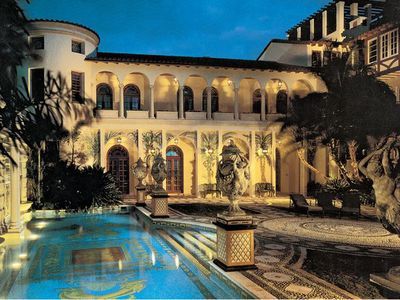
Even producer Ryan Murphy can’t believe he was able to shoot at Villa Casa Casuarina
The South Beach mansion featured in producer Ryan Murphy's new American Crime Story season devoted to the murder of fashion designer Gianni Versace is no movie set. It's the real thing.
Twenty years after Versace's death, Murphy and crew headed to Miami to film parts of the show at the iconic 1930-era home that the designer carefully revived — what is now the boutique hotel The Villa Casa Casuarina. Chauncey Copeland, the hotel’s general manager, told the Associated Press that crew from the FX series spent about a month filming at the hotel. “It’s really striking just how accurate they are,” he said.
The hotel is still a memorial of sorts to Versace, where guests can live like the designer (if only for a weekend).
“We actually have preserved what Versace created here and just augmented it with some modern touches for the convenience of our hotel guests and restaurant patrons,” Copeland told the AP. The mansion’s famous Versace logo-emblazoned mosaic swimming pool is still there, although the hidden passageways the designer once used to traverse the huge mansion are now closed.

The Villa Casa Casuarina/Facebook
Villa Casa Casuarina’s so Versace pool (check out the Medusa logo)
The house itself will be almost be its own character in the The FX’s series The Assassination of Gianni Versace, which will premiere on January 17 with Edgar Ramirez as Versace.
Murphy told Page Six last month he couldn’t believe it when he received the permit to shoot there. “I don’t think I could have made the show if I couldn’t have gotten that house,” he said. “There was no way you could build [a set] of it. Two of the rooms were made out of seashells. [Gianni Versace’s sister] Donatella [Versace] took all the furniture and the art when she sold the house, but through pictures we were able to recreate them.”
“It adds something to the performance,” Murphy told Page Six. “When Edgar Ramirez goes to those Biedermeier closets [in Versace’s bedroom], they were the same closets Versace spent a year building and they’ve been lovingly maintained. They were extraordinary.”
Versace’s former mansion now a luxury hotel in Miami Beach [7 New Miami]
10 of Miami’s most iconic buildings, mapped [Curbed Miami]
Recreating Versace murder emotionally drained Ryan Murphy, cast and crew [Page Six]
from Curbed Miami - All https://miami.curbed.com/2018/1/3/16846594/versace-mansion-american-crime-story-villa-casa-casuarina
0 notes
Text
The Versace Mansion is back in the spotlight, thanks to ‘American Crime Story’

Even producer Ryan Murphy can’t believe he was able to shoot at Villa Casa Casuarina
The South Beach mansion featured in producer Ryan Murphy's new American Crime Story season devoted to the murder of fashion designer Gianni Versace is no movie set. It's the real thing.
Twenty years after Versace's death, Murphy and crew headed to Miami to film parts of the show at the iconic 1930-era home that the designer carefully revived — what is now the boutique hotel The Villa Casa Casuarina. Chauncey Copeland, the hotel’s general manager, told the Associated Press that crew from the FX series spent about a month filming at the hotel. “It’s really striking just how accurate they are,” he said.
The hotel is still a memorial of sorts to Versace, where guests can live like the designer (if only for a weekend).
“We actually have preserved what Versace created here and just augmented it with some modern touches for the convenience of our hotel guests and restaurant patrons,” Copeland told the AP. The mansion’s famous Versace logo-emblazoned mosaic swimming pool is still there, although the hidden passageways the designer once used to traverse the huge mansion are now closed.

The Villa Casa Casuarina/Facebook
Villa Casa Casuarina’s so Versace pool (check out the Medusa logo)
The house itself will be almost be its own character in the The FX’s series The Assassination of Gianni Versace, which will premiere on January 17 with Edgar Ramirez as Versace.
Murphy told Page Six last month he couldn’t believe it when he received the permit to shoot there. “I don’t think I could have made the show if I couldn’t have gotten that house,” he said. “There was no way you could build [a set] of it. Two of the rooms were made out of seashells. [Gianni Versace’s sister] Donatella [Versace] took all the furniture and the art when she sold the house, but through pictures we were able to recreate them.”
“It adds something to the performance,” Murphy told Page Six. “When Edgar Ramirez goes to those Biedermeier closets [in Versace’s bedroom], they were the same closets Versace spent a year building and they’ve been lovingly maintained. They were extraordinary.”
Versace’s former mansion now a luxury hotel in Miami Beach [7 New Miami]
10 of Miami’s most iconic buildings, mapped [Curbed Miami]
Recreating Versace murder emotionally drained Ryan Murphy, cast and crew [Page Six]
from Curbed Miami - All https://miami.curbed.com/2018/1/3/16846594/versace-mansion-american-crime-story-villa-casa-casuarina
via IFTTT
0 notes
Text
German Hat Museum, Lindenberg im Allgäu, Germany
New Post has been published on https://hisour.com/tour/german-hat-museum-lindenberg-im-allgau-germany/
German Hat Museum, Lindenberg im Allgäu, Germany
The German Hat Museum Lindenberg (Deutsches Hutmuseum Lindenberg) Allgäu is a museum on the cultural history of the hat. The Lindenberger Hutmuseum gives an insight into the centuries-old Huttradition the city of Lindenberg. This goes back to the 16th century. At the German Hat Museum Lindenberg visitors can get a glimpse of the hat history. Walk through 300 years of hat fashion and discover familiar, interesting and curious about the topic of headgear. Participants are invited to try out and stow away. Immerse yourself in the history of the creation of a hat with the industrious homeworkers, courageous hatters and powerful manufacturers. The women and men in Lindenberg produced around four million straw hats around 1900. The whole world was wearing hats from Lindenberg. The "Little Paris" of the hat fashion lay in the midst of the tranquil Allgäu. In one of the largest hat factories of the time, the former hat factory Ottmar Reich, you will find the German Hut Museum. History: Since the beginning of the 17th century straw hats were made at home in Lindenberg. The technical knowledge for Hutherstellung had horse traders from Italy in the village in the Allgäu conveyed. From the mid-17th century, the sale of hats from Lindenberg in markets has been handed down. In the year 1755 the hat company, which took over the marketing of the hats for the homeworkers. Unique is the history of hat making. It has actually made Lindenberg what it is today. Starting with the horse trade and crafting in families and micro-enterprises, the center of the German straw hat industry is created in the Westallgäu. Growth and prosperity, worldwide renown follow. The hat museum takes up this theme. Hans Stiefenhofer and Manfred Röhrl have collected the probably most important collection of hat culture in several decades. It takes space and an authentic place, which was created with the opening of the German Hut Museum Lindenberg in the rooms of the former hat factory Ottmar Reich. In December 2014, the new German Hut Museum Lindenberg was officially opened and the following year it was awarded the Bavarian Museum Prize 2015. The conversion of the industrial monument in a museum took two years and cost about 10 million euros, which were financed by two-thirds of funds from the European Union and one-third with funds from the federal government and the Bavarian government. The museum itself is located in the main building of the former hat factory, whereas in the old boiler house at the 28 meter high brick chimney a restaurant was set up. The basis of the exhibits goes back to the collections of the opened in 1981 and closed on October 27, 2013 City Hut Museum Lindenberg. On an exhibition area of almost 1000 m², hats, hat presses, blanks and many other exhibits on the history of hat fashion from three centuries are shown. At the center of the exhibition stands the plastic "Huttornado" composed of white hat casts. The exhibition is divided into the three themes of hat making, hat fashion and the history of the city of Lindenberg as a center of hatmaking. At that time Lindenberg lived from the horse trade with Italy. One of these horse traders, according to tradition, had to overwinter because of illness in Italy. During his involuntary stay in the south, he watched straw weaving and herding and brought this knowledge to Lindenberg. In the beginning, the hats were made only for their own use, but from 1755 began to organize the distribution and production. The first hat factories were founded in the Biedermeier period around 1830; until 1890 there were already 34 straw hat manufacturers. They produced about 8 million straw hats a year. Not surprisingly, then, that Lindenberg at the beginning of the 20th century was considered the center of the German men's straw hat industry and the "Little Paris" was called the hat fashion. At that time, in 1914, the former market Lindenberg was raised to the city. At the beginning of the 19th century, around 300 Lindenberg families worked in the hatmaking industry. In 1835, the first large hat factory was built in place. For the men's fashion, the so-called circular saw was made, for women Florentine hats and bell hats were made. Soon there were not enough raw materials available for hat production in the nearby region, which is why they had to be partially imported from China, as a postcard sent to Lindenberg by a local overseer on the production of braids from the late 19th century proves ] In the first half of the 20th century, Lindenberg produced a total of eight million hats a year in 34 different companies, which earned the city the epithets or epithets "Hat Capital of Europe" and "Little Paris". Hats from Lindenberg not only found sales in Europe but also in the US and South America. In the 1920s, however, the straw hat industry is experiencing a crisis and the companies are trying to counteract with felt, leather, dralon and fur over the next few decades, which succeeds. But then comes with the 60s and 70s, an increasingly hatless fashion. It forces long-established companies to discontinue their production. The hat industry loses its primary position in Lindenberg economic life. Today there is only one well-known hat factory on the site: the company Mayser GmbH & Co.KG. After the First World War, the decline of the straw hat production began because the main product, the circular saw, had gone out of fashion. A certain compensation brought the conversion to the production of felt hats. After the hat lost more and more importance as a piece of clothing in the 1960s, most Lindenberg companies had to cease operations. Since 1997, only a single hat factory in the village maintained its operation, but also closed its doors in 2010. The hat museum reminds of this time, in which lie the origins of today's Lindenberg. In addition, the many steps are modeled using original equipment and machines. The various styles of the past centuries show countless hat models from all eras. Today, in addition to the German Hut Museum Lindenberg still remember the annual Huttag and the election of a queen of hats to the former great economic importance of hat production for the city. The museum won the Bavarian Museum Prize in 2015. Exhibition: German Hat Museum Lindenberg permanent exhibition tells of hard-working homeworkers, courageous traders and powerful manufacturers who have made Lindenberg the "little Paris" of hat fashion. Hut manufacture, Hutstadt Lindenberg and Hutmode are then the three themes that are shown on almost 1000 square meters of accessible area - and this is always accompanied by the matching hat from the extensive collection. On two levels, theme islands or showcases are arranged chronologically around a central installation. The focal point of the first exhibition level is the factory shelf: a glass, walk-in cube that illustrates the technical manufacturing processes of hat making. Its walls are made of "intelligent" glass, whose transparency can be transformed from transparent to milky - creating a room-high production area on the inside. Here the emergence of a hat is cinematically visualized. The pictures were taken at the Lindenberg company Mayser and the hat factory Seeberger in the neighboring village of Weiler. An art installation by Anja Luithle, the Huttornado, welcomes the visitor on the 4th floor. White hats in generous ellipses swirl from floor to ceiling on six dark steel bars. The different replicas of striking hat shapes draw the viewer into the varied cultural history of the hat of the last 300 years. Facing the Huttornado, large-format photographs and pictures show the temporal context and thus shape the spatial picture. They revive the changing fashion trends and complement the productions and exhibits in the showcases. The result is a cross-section of the fashionable development of the hat, both in terms of its regional context and in the international fashion scene of the 19th, 20th and 21st centuries. Depending on the position and viewing angle, there are different emphases and surprising visual references. Structurally, the Huttornado is just above the factory shelf in the plane below him. The hats swirl so symbolically directly out of production and land in their respective time. Spazieren Sie durch 300 Jahre Hutmode und entdecken Sie Vertrautes, Interessantes und Kurioses rund um das Thema Kopfbedeckungen. Mitmachstationen laden zum Ausprobieren und Staunen ein. Bei uns können Sie nach Herzenslust Hüte anprobieren und herausfinden unter welchen Hut Sie passen. Erleben Sie das faszinierende Handwerk der Hutmacher in unserem „Fabrik-Kino" und entdecken Sie in unserem „Huttornado" bekannte und berühmte Hutträger. Im Mittelpunkt unserer Erzählungen stehen die Menschen: fleißige Heimarbeiterin, mutige Huthändler und mächtige Fabrikanten. Über vier Millionen Strohhüte produzierten die Frauen und Männer hier um 1900. Die ganze Welt trug Hüte aus Lindenberg. Das „Klein-Paris" der Hutmode lag mitten im beschaulichen Allgäu. In einer der größten Hutfabriken jener Zeit, der ehemaligen Hutfabrik Ottmar Reich, finden Sie heute das Deutsche Hutmuseum. Hutherstellung, Hutmode und Hutstadt - auf fast 1000 qm barrierearmer Fläche zeigen wir Ihnen drei abwechslungsreiche Themen und dazu immer den passenden Hut aus unserer Sammlung. Ein Hutmuseum dieser Art und Größe ist deutschlandweit einmalig.
0 notes
Photo

Emily, Lady Isham by Richard Buckner (Lamport Hall - Lamport, Northamptonshire UK). From bbc.co (now artuk.org) 729X944.
#early Victorian fashion#Romantic era fashion#Biedermeier fashion#Louis-Philippe fashion#Emily - Lady Isham#straight hair lappets#lace bertha#bow#wrap#full skirt
83 notes
·
View notes
Photo

Woman by Franz Xaver Winterhalter (location ?). From jeannepompadour.tumblr.com-image-153140436021 1648X2057.
#early Victorian fashion#Romantic era fashion#Biedermeier fashion#Louis-Philippe fashion#Franz Xaver Winterhalter#hair jewelry#V décolletage#lace-trimmed bertha#V waistline#crinoline
76 notes
·
View notes
Photo

ca. 1828 Paulína von Lebzeltern by Konstantin Danil (Galéria mesta Bratislavy - Bratislava-Staré Mesto, Slovakia). From tumblr.com/history-of-fashion, Her bodice has fan-like pleats.
#1820s fashion#Romantic era fashion#Biedermeier fashion#French Restoration fashion#Paulína von Lebzeltern#Konstantin Danil#large curl coiffure#knotted bun#off-shoulder straight neckline#belt#wrap
90 notes
·
View notes
Photo
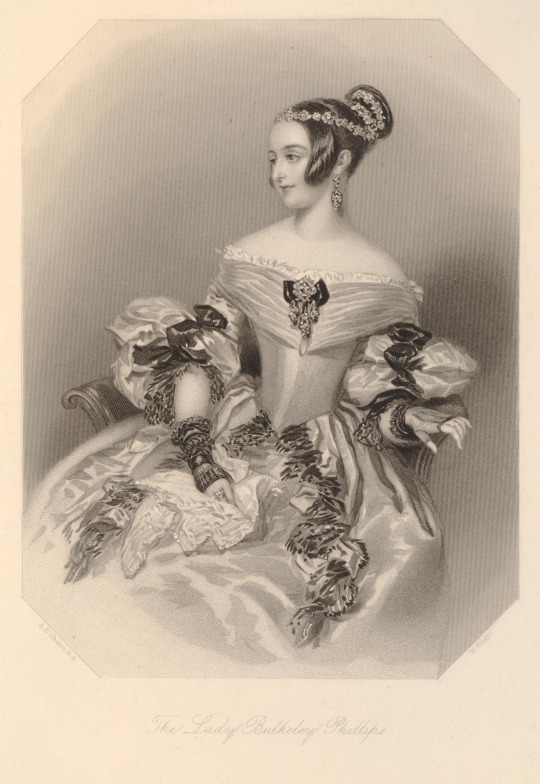





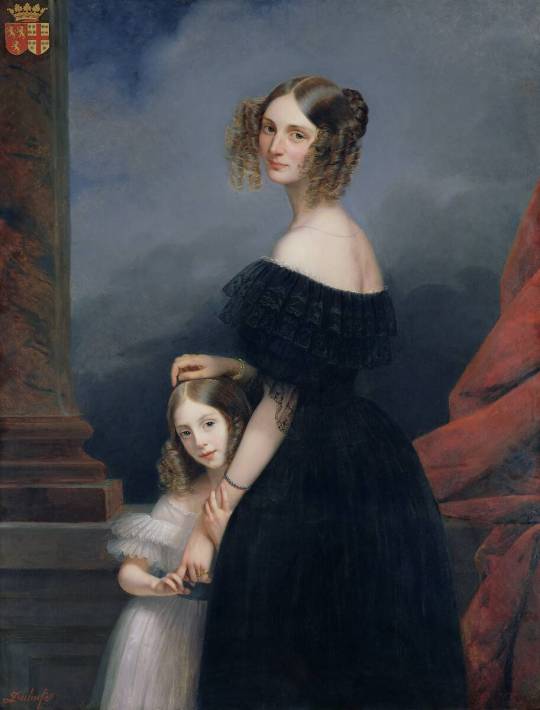

Around 1840 -
Top row 1840 Lady Eliza Gordon wearing elaborately ribboned dress by William Knight after A. E. Chalon (British Museum - London, UK). From their Web site 1232X1788.
Second row 1840s (early) Marie Duplessis as la Dame aux Camelias by Jean-Charles Olivier (auctioned by Sotheby's), From their Web site 2883X3965.
Third row ca. 1840 Angela Georgina Burdett-Coutts, Baroness Burdett-Coutts by ? (National Portrait Gallery - London UK). 2400X2969 @72 1.8Mj.
Fourth row left 1840s Zinaida Yussupova (Naryshkina) by Christina Robertson (location ?). From Wikimedia. Blured bkgnd, face and neckline removed spots 2330X2854.
Fourth row right ca. 1840 Alexandra Nikolaievna by Vladimir Hau (State Open-air Museum Peterhof - St. Petersburg, St. Petersburg Federal City, Russia). From vsdn.ru/museum/catalogue/exhibit1251.htm 899X1134..
Fifth row ca. 1840 Family of the Entrepreneur I. J. Wehle by Antonin Machek (City of Prague Museum - Praha, Czech Republic). From Animus Mirabilis' photostream on flickr 1651X2048.
Sixth row left ca. 1840 Anne-Louise Alix de Montmorency, with her daughter by Claude-Marie Dubufe (location ?) From en.muzeo.com/art-print/portrait-of-anne-louise-alix-de-montmorency/claude-marie-dubufe 913X1200.
Sixth row right ca. 1840 Former Brazilian Empress Dona Amélie of Leuchtenberg with her daughter Dona Maria Amélia, Princess of Brazil by Friedrich Dürck (Swedish Royal Collection). From Wikimedia; fixed spots & flaws w Pshop 974X1218
#1840s fashion#early Victorian fashion#Romantic era fashion#Biedermeier fashion#Louis-Philippe fashion#Eliza Gordon#William Knight#Alfred Edward Chalon#off shoulder straight neckline#pleated bertha#Marie Duplessis#Jean-Charles Olivier#veil#Angela Georgina Burdett-Coutts#straight hair#Zinaida Yussupova the elder#Christina Robertson#chemise#Alexandra Nikolaievna#Vladimir Hau#laced bodice#floral headdress#Antonin Machek#full skirt#Anne-Louise Alix de Montmorency#Claude-Marie Dubufe#side curl coiffure#Amélie of Leuchtenberg#Friedrich Dürck#off shoulder V neckline
29 notes
·
View notes
Photo

1840 Caroline Amelie's coronation robe (Rosenborg Slot - København, Denmark). From kongernessamling.dk/en/rosenborg/object/coronation-robe-2/# 2200X2525 @300 1.6Mj.
#1840s fashion#early Victorian fashion#Romantic era fashion#Biedermeier fashion#Queen Caroline Amelie of Denmark#coronation dress#scoop neckline#elbow-length sleeves#V waistline#over-skirt#petticoat#train
51 notes
·
View notes
Photo

Lady by Felice Schiavoni (auctioned by Doirotheum). From Wikimedia; fixed edges, spots, cracks, & tears w Pshop 1162X1412.
#early Victorian fashion#Romantic era fashion#Louis-Philippe fashion#Biedermeier fashion#straight hair#side curl coiffure#V neckline#darts#V waistline#fur wrap
27 notes
·
View notes
Photo
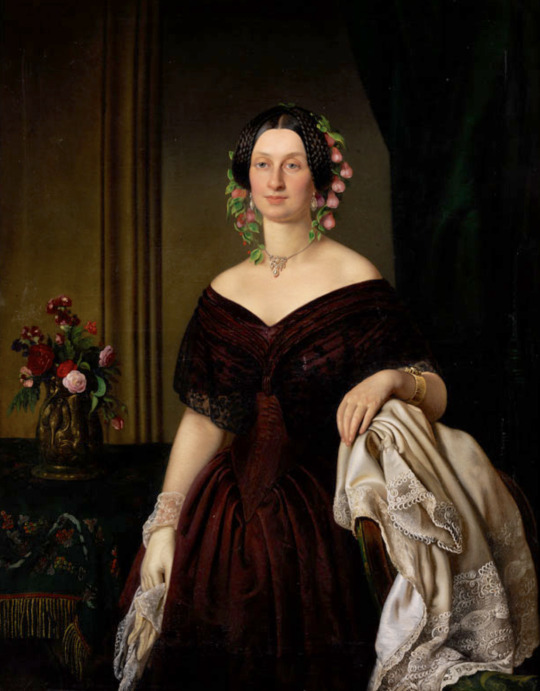
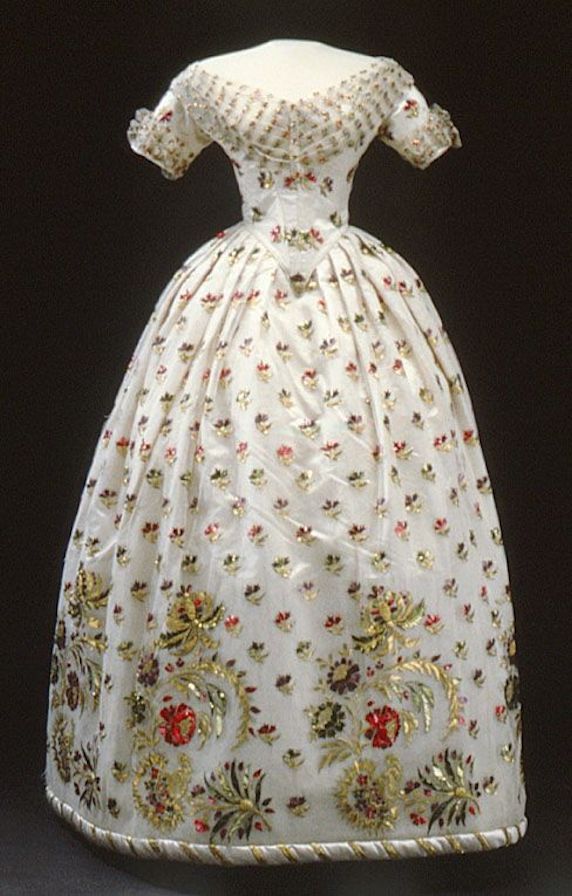
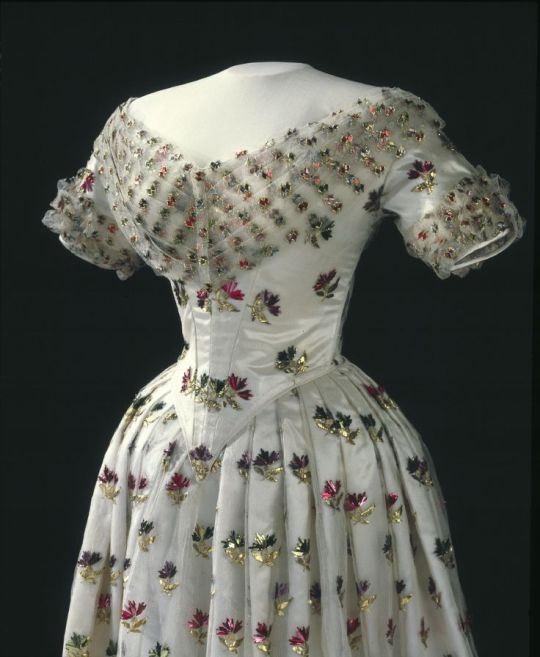
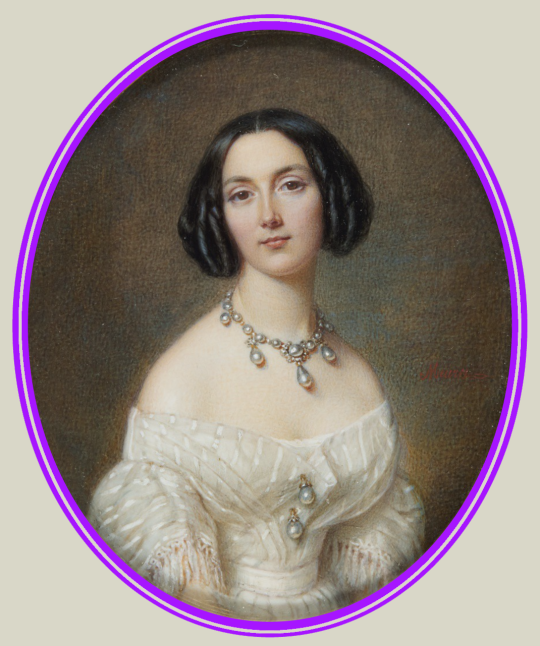

Around 1840 -
Top Elisabeth, Freifrau von Oefele by Josef Karl Stieler (auctioned by Hampel). From their Web site via pinterest.com/andrewschroeder/1840s-art/; filled in shadows 40% 1758X2250 @144 3.6Mp.
Second row left ca. 1840s Evening dress (location ?). From threadingthroughtime.wordpress.com/2014/06/20/your-weekend-wow-19/ 572X896.
Second row right ca. 1840s Detail of dress satin lined with tulle floral embroidery in metallic threads tulle and ribbon-trim (location ?). From threadingthroughtime.wordpress.com/2014/06/20/your-weekend-wow-19/ 736X896.
Third row ca. 1840 Lady, probably Marie Charlotte, marquise de Bonneval, née de Segur by François Meuret (auctioned by Sotheby's). From their Web site 1070X1281.
Fourth row 1841 Countess Sofia Stepanovna Apraksina by Olga Golitsyn (Tomskiy Oblastnoy Khudozhestvennyy Muzey/Tomsk Oblast Art Museum - Tomsk, Tomsk Oblast, Russia). From Wikimedia; removed spots with Photoshop
#1840s fashion#Louis-Philippe fashion#Biedermeier fashion#early Victorian fashion#Romantic era fashion#Elisabeth Freifrau von Oefele#Josef Karl Stieler#side braid coiffure#hair flowers#off shoulder V neckline#pleated bodice#V neckline#full skirt#wrap#Marie Charlotte de Segur#François Meuret#natural waistline#waist band#Sofia Stepanovna Apraksina#Olga Golitsyn#turban#veil#lace bertha#V waistline#fur-trimmed wrap
20 notes
·
View notes
Photo

1825 Agnes Rauch (1804-81) by Wilhelm Schadow (Hamburger Kunsthalle - Hamburg, Freie und Hansestadt Hamburg, Germany). From meisterdrucke.uk/fine-art-prints/Friedrich-Wilhelm-von-Schadow/70493/Agnes-Rauch-%281804-81%29,-1825-.html 742X1924.
#1820s fashion#Romantic era fashion#Biedermeier fashion#French Restoration fashion#Agnes Rauch#Wilhelm Schadow#straight hair#U neckline#quarter-length full sleeves#waist band#close skirt.wrap
35 notes
·
View notes